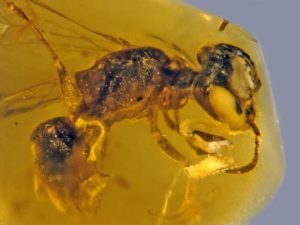Bees Originated in Western Gondwana before Breakup of Africa and South America, Study Suggests
by News Staff
Bees are the most significant pollinators of flowering plants. This partnership began approximately 120 million years ago, but the uncertainty of how and when bees spread across the planet has greatly obscured investigations of this key mutualism. New research led by Universidade de São Paulo and Washington State University scientists demonstrates that bees originated in western Gondwana (Africa and South America) in the Early Cretaceous epoch and that the early evolution of any major bee lineage is associated with either the South American or African land masses.

The pollen-collecting bee Discoscapa apicula found in a piece of 99-million-year-old amber (mid-Cretaceous period) from Myanmar. Image credit: George Poinar Jr. / College of Science, Oregon State University.
“There’s been a longstanding puzzle about the spatial origin of bees,” said Washington State University’s Dr. Silas Bossert, co-senior author of the study.
For the study, Dr. Bossert, co-senior author Dr. Eduardo Almeida from the University of São Paulo, and their colleagues sequenced and compared genes from more than 200 bee species.
They compared them with traits from 185 different bee fossils, as well as extinct species, developing an evolutionary history and genealogical models for historical bee distribution.
In what may be the broadest genomic study of bees to date, they analyzed hundreds to thousands of genes at a time to make sure that the relationships they inferred were correct.
“This is the first time we have broad genome-scale data for all seven bee families,” said co-author Dr. Elizabeth Murray, also from Washington State University.
Previous research established that the first bees likely evolved from wasps, transitioning from predators to collectors of nectar and pollen
The current study shows they arose in arid regions of western Gondwana during the early Cretaceous period.
“For the first time, we have statistical evidence that bees originated on Gondwana,” Dr. Bossert said.
“We now know that bees are originally southern hemisphere insects.”
The researchers found evidence that as the new continents formed, bees moved north, diversifying and spreading in a parallel partnership with angiosperms, the flowering plants. Later, they colonized India and Australia.
All major families of bees appeared to split off prior to the dawn of the Tertiary period, 65 million years ago — the era when dinosaurs became extinct.
The tropical regions of the western hemisphere have an exceptionally rich flora, and that diversity may be due to their longtime association with bees.
One quarter of all flowering plants belong to the large and diverse rose family, which make up a significant share of the tropical and temperate host plants for bees.
The authors now plan to continue their efforts, sequencing and studying the genetics and history of more species of bees.
Their findings are a useful first step in revealing how bees and flowering plants evolved together.
Understanding how bees spread and filled their modern ecological niches could also help keep pollinator populations healthy.
“People are paying more attention to the conservation of bees and are trying to keep these species alive where they are,” Dr. Murray said.
“This work opens the way for more studies on the historical and ecological stage.”
The results were published in the journal Current Biology.
_____
Eduardo A.B. Almeida et al. The evolutionary history of bees in time and space. Current Biology, published online July 27, 2023; doi: 10.1016/j.cub.2023.07.005
We are here to share current happenings in the bee industry. Bee Culture gathers and shares articles published by outside sources. For more information about this specific article, please visit the original publish source: Bees Originated in Western Gondwana before Breakup of Africa and South America, Study Suggests | Sci.News








